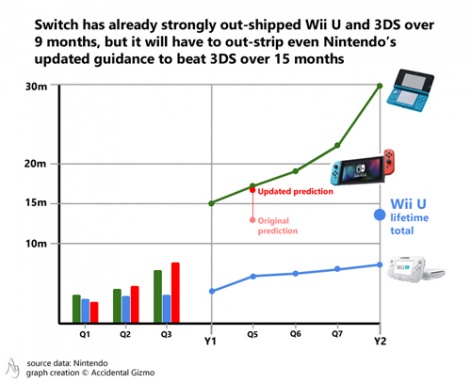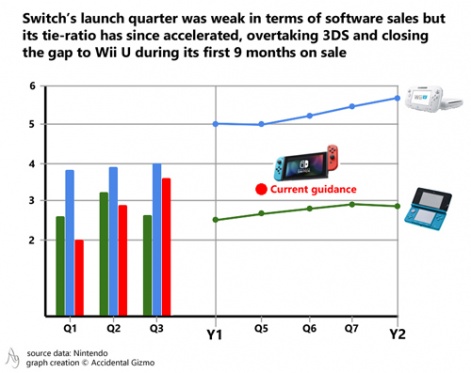Best described as the duck-billed platypus of the console world, Nintendo’s dual-use Switch is a tricky beast to pin down.
Nine months into its lifespan and Nintendo remains convinced it can beat Wii’s 101 million lifetime total and become the company’s best-selling home console.
Certainly Switch will beat the 13.6 million units Wii U sold in its five years within its first 15 months, or possibly even 12 months, and it may even beat 3DS’ 15 month total of 17 million.
Yet, aside from the constant speculation about hardware sales and production capacity, the biggest unknown remains how players use it.
Just as the platypus confused early botanists with its duck-bill and egg-laying abilities, so with Nintendo's home console in terms of its handheld properties (or vice versa).
Flip, reverse it
In the company recent financial report, we got our first clue about how that situation is playing out, however.

30% of players are using their Switch primarily in handheld mode (Nintendo defines ‘primarily’ as being more than 80% of the time), while only 18% are using it primarily as a home console.
Unhelpfully, the remaining 52% is labelled as ‘Playing in both modes’, although Nintendo could, presumably, have provided more detail about which mode dominates.
Home and away
The reason this is important is Nintendo’s home and handheld consoles have trended to very different trajectories in terms of how many hardware units they've sold, as well as how many games have been sold per console.
Just as the platypus confused early botanists, so with Switch - a home console with handheld abilities.
For example, only two of Nintendo’s home consoles have sold more than 50 million units (NES and Wii), while all of its handheld consoles have sold more than 50 million units. And two of these (Game Boy and DS) sold more than 100 million, with the DS being Nintendo’s top seller ever with a total of 154 million.
When it comes to the number of games sold per console (better known as tie-ratio), home consoles have a clear advantage, however.
The N64 has the lowest tie-ratio of Nintendo home consoles with a lifetime total of 6.8 games sold per console, while Nintendo’s best performing handheld with respect to tie-ratio was the DS with 6.2 games sold per console.
In terms of overall average, Nintendo handhelds average five games per console, while home consoles average 8.1, which is a stark difference when you consider Nintendo makes the majority of its profits from software.
Best of both worlds
So how does Switch measure up in this context? Well, like the platypus, it plays both ways.
In terms of hardware sales, it’s out-shipped 3DS during its first three quarters (nine months) and looks likely to maintain that pace over the next six months.
Nintendo’s updated guidance suggests it will ship 16.7 million Switches during the console’s first 15 months, which would compare to 17.1 million 3DSs shipped during the equivalent period.
However, given even Nintendo’s new guidance could be considered conservative, it wouldn't be a surprise if Switch doesn’t beat 3DS over this timeframe.

In the medium-term, the bigger challenge will be if Switch can match 3DS’ 24 month total of 30 million units.
Yet, when we consider Switch’s tie-ratio, it’s clear the console is matching Wii U’s performance, although it’s worth noting some caveats.
By definition, the fewer consoles sold, the higher a tie-ratio is likely to be, especially during launch year. This is because hardcore fans are likely to buy more games than the mass market audience a console attracts if it has higher hardware sales.

In this respect, the fact Switch has high hardware sales and a high tie-ratio is impressive but unlikely to be sustained at this level.
As can be seen on the graph, Nintendo’s updated guidance, which added five million hardware shipments and 15 million software shipments to FY17 total, has the impact of taking Switch’s current tie-ratio from 3.6, down to 3.3 over the next six months.
This is because Nintendo predicts a more than doubling of hardware shipments but those new Switch owners are more likely to buy a couple of games rather than the three or four needed to maintain the current tie-ratio.
The result has to be a short-term decline in tie-ratio, although it will - of course - rise again over time.
Future proofs
And, more generally, it seems it’s going to take another 12 months or so to get an accurate grasp of how Switch player behaviour will stabilise, both in terms of playing patterns and game purchases.
- Will it continue to outsell 3DS hardware-wise?
- Can games sales continue at the current rate if 2018 fails to provide titles of the quality of Super Mario Odyssey, Mario Kart 8 Deluxe, Splatoon 2 and Legend of Zelda: Breath of the Wild?
For what it’s worth, my gut feeling is Switch will end up more of a handheld console than a home one in terms of usage; one that sells more than 50 million units, doesn’t break Wii’s total, but which ends up with a tie-ratio of more than six games.
Correct or not, though, over the next six months it seems certain that, like the duck-billed platypus, Nintendo will continue to have the best of both worlds.

















